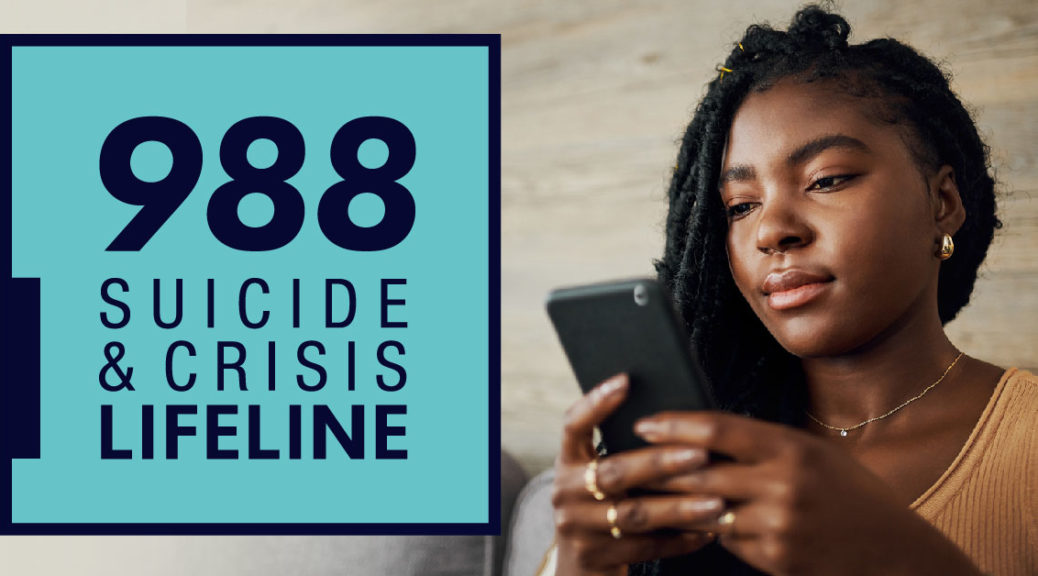What You Need to Know About the Suicide Prevention Hotline Changing to 988

The Federal Communication Commission (FCC) has created a new 3-digit dialing code that will connect callers to the nationwide suicide prevention hotline for mental health crises. Just like we’re trained from childhood to call 911 for immediate assistance with fire, health or safety emergencies, now 988 is designed to be a resource for immediate mental health emergencies, people at risk of suicide and other crises.
With an estimated launch of July 16, 2022, the number will be open to help those in crisis find the support and resources they need. What services will the hotline provide? Who’s it for? What can you do to help those experiencing a mental health crisis? Let’s explore everything you need to know about this new life-saving hotline.
What is the 988 Suicide & Crisis Lifeline?
The new 988 hotline aims to be a free, confidential suicide prevention number and crisis line for people experiencing any type of mental distress. Previously, the National Suicide Prevention Lifeline was an eleven digit 1-800 number.
 In shifting to a three-digit code, there’s hope that those reaching out for mental health emergencies will become a routine, destigmatized response to mental health crises. Just like calling 911 is the instinct when you smell smoke, 988 may become an instinctive call when a mental health emergency occurs. You can call, text, or chat online and receive help immediately.
In shifting to a three-digit code, there’s hope that those reaching out for mental health emergencies will become a routine, destigmatized response to mental health crises. Just like calling 911 is the instinct when you smell smoke, 988 may become an instinctive call when a mental health emergency occurs. You can call, text, or chat online and receive help immediately.
For years, the National Suicide Prevention Lifeline has offered life-saving support: The lifeline received nearly 2.4 million calls in 2020 alone. Those who call the 988 hotline will connect directly with a 24/7 crisis call center offering trained professionals and free immediate help.
Rerouting mental health crises from 911 is another positive result of launching the 988 hotline. Those needing mental health support will find the more specific assistance they need when they call the 988 number, as respondents at 988 are trained and equipped to handle mental health situations.
More to Know About the 988 Hotline
As you seek to spread the word about 988, here are a few things to keep in mind about the new number and its resources.
- Think you won’t need 988? Someone you care about might. In 2020 alone, the U.S. had one death by suicide about every 11 minutes. For people aged 10 – 34 years, suicide is a leading cause of death. Additionally, from April 2020 to 2021, over 100,000 individuals died from drug overdoses. So even if you don’t think you’ll need the 988 hotline, someone you care about may. You can also call the line on behalf of someone else. If a loved one has expressed a desire to harm themselves or is experiencing a mental health crisis, you can reach out for support and helpful information.
- 988 offers support beyond suicide prevention and can be helpful for any kind of mental distress, substance abuse included. The long-term vision for 988 is a robust, national crisis care response system that links callers to community-based providers for a full range of crisis care services, as well as tools and resources to help prevent future crises.
- The 988 hotline aims for accessibility and inclusivity. The line offers communication options in 150 languages for call, text or chat.
- Trained counselors staff the hotline with experience and expertise in de-escalating crises. This professional training can be a crucial element that makes a difference in a serious situation.
- Make sure the 988 hotline is live and operational in your state before sharing it with those around you. Infrastructure may differ between states, so ensuring the hotline is live and in practice before calling is essential. For people in states where the line isn’t yet up and running, 911 will still be an ideal resource.
How the National Suicide Prevention Hotline Helps
Over the years of its service, the National Suicide Prevention Lifeline has a proven track record. A survey by the FCC revealed that those who called the suicide prevention number were “significantly more likely to feel less depressed, less suicidal, less overwhelmed, and more hopeful by the end of calls.”

These positive results were all seen when the suicide prevention hotline was a less memorable 1-800 number. With the move to 988, the National Suicide Prevention Lifeline has the opportunity to make a more significant impact and expand to help those facing mental health crises of many kinds. The mental health crisis continues to grow across the country, with the percentage of adults with a mental illness reporting unmet treatment needs increasing every year since 2011 — which means 988 has the potential to make a dramatic impact.
What Can You Do to Help Prevent Suicide?
There are many things caregivers, family and friends can do to support those around them who experience depression, suicidal thoughts and mental health challenges of other kinds. Here are several impactful strategies you can take to be part of a robust support system.
- Take care to check in. Mental health wellness can have its peaks and dips depending on circumstances, physical health and more. You can be an essential part of a support system by checking in with compassion. What behaviors are you seeing? Have habits or routines drastically changed? Often, reaching out for help is most difficult when it’s most needed. So make it a point to ask a loved one how they’re doing and be prepared to listen. It can be helpful to share encouraging words and a verbal reminder that you’re available for support.
- Find helpful resources. As you educate yourself on mental health, you’ll likely come upon resources that may help the person you know in need. Could they benefit from mental health treatment? We have a quick mental health assessment to help you find the answer. With these resources and more in hand, you’ll be prepared to offer the assistance needed when the time is right. You can learn about the warning signs and risk factors of suicide here.
- Talk about it. By sharing positive mental health messages, you can play a part in removing the stigma from these challenges. Share helpful articles and resources. Listen to the struggles of those around you and encourage them to seek professional help when needed. Reassure them that they’re not alone. You can make a difference when someone around you is suffering and needs support.
Additional Resources
For more resources on suicide, consider the following:
- Text HOME to 741741 for 24/7 support from the Crisis Text Line
- Get specialized LGBTQIA+ mental health support from The Trevor Project at (866) 488-7386 or text START to 678-678
- Find local peer support at Warm Lines
- Call the Suicide Prevention Lifeline at 1-800-273-8255
- Use the Disaster Distress helpline at 1-800-985-5990 or text TalkWithUs at 66746
- Read more KVC blogs about suicide prevention
About KVC
KVC Health Systems makes a positive difference in the lives of over 70,000 people each year. By providing medical and behavioral healthcare, social services and education, we are enriching and enhancing the lives of children and families. We provide compassionate treatment for people with a range of mental health or psychiatric disorders, as well as those dealing with the effects of traumatic stress. Learn more about our mental health services in Kansas, Missouri, Nebraska, Kentucky and West Virginia. We also provide trauma-informed residential psychiatric treatment programs as well as acute hospitalization at our children’s psychiatric hospitals and residential treatment centers in Kansas and Missouri. Learn more here on our KVC Hospitals website.





